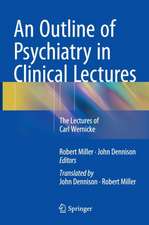Methods of Assessing the Reinforcing Properties of Abused Drugs
Editat de Michael A. Bozarthen Limba Engleză Paperback – iul 2012
Preț: 736.39 lei
Preț vechi: 775.14 lei
-5% Nou
Puncte Express: 1105
Preț estimativ în valută:
140.91€ • 147.49$ • 117.28£
140.91€ • 147.49$ • 117.28£
Carte tipărită la comandă
Livrare economică 31 martie-14 aprilie
Preluare comenzi: 021 569.72.76
Specificații
ISBN-13: 9781461291633
ISBN-10: 1461291631
Pagini: 676
Ilustrații: XIV, 658 p.
Dimensiuni: 155 x 235 x 35 mm
Greutate: 0.93 kg
Ediția:Softcover reprint of the original 1st ed. 1987
Editura: Springer
Colecția Springer
Locul publicării:New York, NY, United States
ISBN-10: 1461291631
Pagini: 676
Ilustrații: XIV, 658 p.
Dimensiuni: 155 x 235 x 35 mm
Greutate: 0.93 kg
Ediția:Softcover reprint of the original 1st ed. 1987
Editura: Springer
Colecția Springer
Locul publicării:New York, NY, United States
Public țintă
ResearchCuprins
Self-Administration Studies.- 1: Intravenous self-administration: Response rates, the effects of pharmacological challenges, and drug preferences.- 2: Screening for drug reinforcement using intravenous self-administration in the rat.- 3: Assessing drugs for abuse liability and dependence potential in laboratory primates.- 4: Interpretation of lesion effects on stimulant self-administration.- 5: Second-order schedules of drug injection.- 6: Intravenous drug self-administrations A special case of positive reinforcement.- 7: Oral drug self-administrations Drugs as reinforcers.- 8: Oral self-administration of alcohols A valid approach to the study of drug self-administration and human alcoholism.- 9: Intracranial self-administration procedures for the assessment of drug reinforcement.- 10: Prediction of drug abuse liability from animal studies.- Conditioning Studies.- 11: Conditioned reinforcement as a measure of the rewarding properties of drugs.- 12: Reinstatement of drug-taking behavior as a method of assessing incentive motivational properties of drugs.- 13: Place conditionings A simple and effective method for assessing the motivational properties of drugs.- 14: Conditioned place preferences A parametric analysis using systemic heroin injections.- 15: Anatomical and neurochemical substrates of drug reward determined by the conditioned place preference technique.- Drug Discrimination Studies.- 16: Applications and limitations of the drug discrimination method for the study of drug abuse.- 17: Drug discriminations Methods of manipulation, measurement, and analysis.- 18: The study of structure-activity relationships using drug discrimination methodology.- Brain Stimulation Reward Studies.- 19: Tests involving pressing for intracranial stimulation as an early procedure forscreening likelihood of addiction of opioids and other drugs.- 20: Brain-stimulation rewards Measurement and mapping by psychophysical techniques and quantitative 2-[14C] deoxyglucose autoradiography.- 21: A comparison of two methods designed to rapidly estimate thresholds of rewarding brain stimulation.- 22: A multifunctional on-line brain stimulation systems Investigation of alcohol and aging effects.- 23: Combined microinjection and brain stimulation reward methodology for the localization of reinforcing drug effects.- Assessment in Humans.- 24: Addiction Research Center Inventory (ARCI) Measurement of euphoria and other drug effects.- 25: Operant analysis of human drug self-administrations Marihuana, alcohol, heroin, and polydrug use.- 26: A drug preference procedure for use with human volunteers.- 27: Clinical procedures for the assessment of abuse potential.- Other Considerations.- 28: Operationalizing and measuring the organizing influence of drugs on behavior.- 29: The mouse as a subject in the study of neural mechanisms of reward.- 30: An overview of assessing drug reinforcement.












